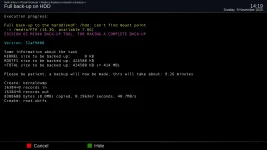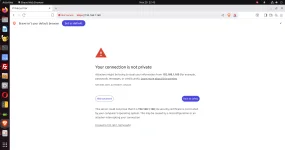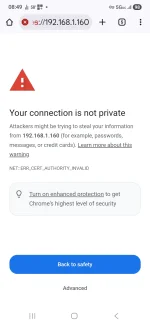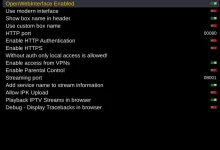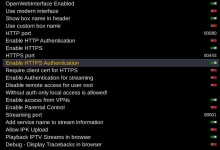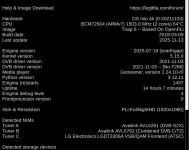el bandido
TNAP-Images
I think you are missing a piece of the puzzle. The path has to be exactly this: /media/usb/ServiceScan
Or exact path: /media/FTA/ServiceScan
Or exact path: /hdd/ServiceScan
If none of those paths can be found, then the reports are dumped into /tmp, and there is no folder provision for /tmp
Also understand the /tmp folder is dumped during a reboot and that is why I call it the temporary folder!
It has been like this for years. Normally when you stick an usb drive into the receiver, you automatically get: /media/usb
And the name of the Folder has to be exactly ServiceScan
Here is what one of my receiver's looks like:
Or exact path: /media/FTA/ServiceScan
Or exact path: /hdd/ServiceScan
If none of those paths can be found, then the reports are dumped into /tmp, and there is no folder provision for /tmp
Also understand the /tmp folder is dumped during a reboot and that is why I call it the temporary folder!
It has been like this for years. Normally when you stick an usb drive into the receiver, you automatically get: /media/usb
And the name of the Folder has to be exactly ServiceScan
Here is what one of my receiver's looks like:
Code:
root@sf8008:~# ls -lh /media/usb/ServiceScan/
-rw-r--r-- 1 root root 1.3K Sep 21 21:13 100.9W_Ku-band_113ch_1tp_09-21-2025_21-13-52.xml
-rw-r--r-- 1 root root 1.4K Oct 2 00:24 100.9W_Ku-band_114ch_1tp_10-02-2025_00-24-55.xml
-rw-r--r-- 1 root root 1.4K Oct 2 00:26 100.9W_Ku-band_114ch_1tp_10-02-2025_00-26-01.xml
-rw-r--r-- 1 root root 1.3K Sep 20 15:38 100.9W_Ku-band_11ch_1tp_09-20-2025_15-38-25.xml
-rw-r--r-- 1 root root 1.3K Sep 21 07:50 100.9W_Ku-band_17ch_1tp_09-21-2025_07-50-29.xml
-rw-r--r-- 1 root root 1.3K Sep 21 07:51 100.9W_Ku-band_17ch_1tp_09-21-2025_07-51-49.xml
-rw-r--r-- 1 root root 1.3K Sep 20 21:32 101.0W_Ku-band_113ch_1tp_09-20-2025_21-32-09.xml
-rw-r--r-- 1 root root 1.3K Sep 20 21:33 101.0W_Ku-band_113ch_1tp_09-20-2025_21-33-30.xml
-rw-r--r-- 1 root root 1.3K Sep 20 21:35 101.0W_Ku-band_113ch_1tp_09-20-2025_21-35-47.xml
-rw-r--r-- 1 root root 1.3K Sep 20 21:41 101.0W_Ku-band_113ch_1tp_09-20-2025_21-41-28.xml
-rw-r--r-- 1 root root 1.3K Sep 20 21:51 101.0W_Ku-band_113ch_1tp_09-20-2025_21-51-27.xml
-rw-r--r-- 1 root root 1.3K Sep 20 22:27 101.0W_Ku-band_113ch_1tp_09-20-2025_22-27-22.xml
-rw-r--r-- 1 root root 1.3K Sep 20 22:30 101.0W_Ku-band_113ch_1tp_09-20-2025_22-30-43.xml
-rw-r--r-- 1 root root 1.3K Sep 21 21:14 101.0W_Ku-band_113ch_1tp_09-21-2025_21-14-35.xml
-rw-r--r-- 1 root root 1.3K Oct 28 09:07 101.0W_Ku-band_114ch_1tp_10-28-2025_09-07-08.xml
-rw-r--r-- 1 root root 1.3K Sep 20 15:39 101.0W_Ku-band_11ch_1tp_09-20-2025_15-39-59.xml
-rw-r--r-- 1 root root 1.3K Sep 20 19:20 101.0W_Ku-band_11ch_1tp_09-20-2025_19-20-11.xml
-rw-r--r-- 1 root root 1.3K Sep 20 20:21 101.0W_Ku-band_11ch_1tp_09-20-2025_20-21-41.xml
-rw-r--r-- 1 root root 1.3K Sep 20 21:00 101.0W_Ku-band_11ch_1tp_09-20-2025_21-00-27.xml
-rw-r--r-- 1 root root 1.3K Sep 20 21:05 101.0W_Ku-band_11ch_1tp_09-20-2025_21-05-43.xml
-rw-r--r-- 1 root root 1.3K Sep 20 21:09 101.0W_Ku-band_11ch_1tp_09-20-2025_21-09-03.xml
-rw-r--r-- 1 root root 1.3K Sep 20 21:37 101.0W_Ku-band_11ch_1tp_09-20-2025_21-37-25.xml
-rw-r--r-- 1 root root 16.4K Sep 20 20:42 101.0W_Ku-band_166ch_16tp_09-20-2025_20-42-15.xml
-rw-r--r-- 1 root root 16.5K Sep 21 00:20 101.0W_Ku-band_168ch_16tp_09-21-2025_00-20-13.xml
-rw-r--r-- 1 root root 16.6K Oct 28 08:21 101.0W_Ku-band_168ch_16tp_10-28-2025_08-21-59.xml
-rw-r--r-- 1 root root 1.3K Sep 20 23:06 101.0W_Ku-band_17ch_1tp_09-20-2025_23-06-45.xml
-rw-r--r-- 1 root root 1.3K Sep 20 23:10 101.0W_Ku-band_17ch_1tp_09-20-2025_23-10-08.xml
-rw-r--r-- 1 root root 1.3K Sep 20 23:32 101.0W_Ku-band_17ch_1tp_09-20-2025_23-32-53.xml
-rw-r--r-- 1 root root 1.3K Sep 20 23:38 101.0W_Ku-band_17ch_1tp_09-20-2025_23-38-48.xml
-rw-r--r-- 1 root root 1.3K Sep 21 00:07 101.0W_Ku-band_17ch_1tp_09-21-2025_00-07-55.xml
-rw-r--r-- 1 root root 1.3K Sep 21 06:43 101.0W_Ku-band_17ch_1tp_09-21-2025_06-43-21.xml
-rw-r--r-- 1 root root 1.3K Sep 21 07:52 101.0W_Ku-band_17ch_1tp_09-21-2025_07-52-39.xml
-rw-r--r-- 1 root root 1.3K Sep 21 20:51 101.0W_Ku-band_17ch_1tp_09-21-2025_20-51-03.xml
-rw-r--r-- 1 root root 1.6K Sep 21 19:33 101.1W_C-band_16ch_1tp_09-21-2025_19-33-04.xml
-rw-r--r-- 1 root root 1.6K Sep 30 21:51 101.1W_C-band_16ch_1tp_09-30-2025_21-51-29.xml
-rw-r--r-- 1 root root 191.2K Oct 8 02:05 105.1W_C-band_2097ch_18tp_10-08-2025_02-05-01.xml
-rw-r--r-- 1 root root 2.3K Oct 30 11:42 105.1W_C-band_24ch_1tp_10-30-2025_11-42-42.xml
drwxrwxr-x 2 root root 4.0K Apr 23 2025 105w-pid-test
-rw-r--r-- 1 root root 24.3K Sep 29 00:03 117.0W_Ku-band_296ch_30tp_09-29-2025_00-03-01.xml
-rw-r--r-- 1 root root 5.6K Oct 26 08:33 127.1W_C-band_63ch_7tp_10-26-2025_08-33-59.xml
-rw-r--r-- 1 root root 9.3K Oct 25 11:55 133.1W_C-band_113ch_9tp_10-25-2025_11-55-54.xml
-rw-r--r-- 1 root root 3.0K Oct 20 10:37 87.1W_Ku-band_11ch_12tp_10-20-2025_10-37-31.xml
-rw-r--r-- 1 root root 3.2K Oct 18 13:20 87.1W_Ku-band_13ch_13tp_10-18-2025_13-20-09.xml
-rw-r--r-- 1 root root 3.6K Oct 20 11:02 87.1W_Ku-band_19ch_13tp_10-20-2025_11-02-07.xml
-rw-r--r-- 1 root root 3.7K Oct 23 12:36 87.1W_Ku-band_20ch_14tp_10-23-2025_12-36-10.xml
-rw-r--r-- 1 root root 2.0K Oct 28 19:45 87.1W_Ku-band_4ch_9tp_10-28-2025_18-45-39.xml
-rw-r--r-- 1 root root 735 Oct 17 20:20 89.1W_C-band_1ch_1tp_10-17-2025_20-20-33.xml
-rw-r--r-- 1 root root 734 Oct 19 11:03 89.1W_C-band_1ch_1tp_10-19-2025_11-03-36.xml
-rw-r--r-- 1 root root 1.5K Oct 14 17:04 89.1W_C-band_2ch_6tp_10-14-2025_17-04-30.xml
-rw-r--r-- 1 root root 1.7K Nov 6 20:49 89.1W_C-band_4ch_7tp_11-06-2025_20-49-06.xml
-rw-r--r-- 1 root root 1.7K Oct 17 20:19 89.1W_C-band_5ch_6tp_10-17-2025_20-19-14.xml
-rw-r--r-- 1 root root 1.7K Oct 17 20:24 89.1W_C-band_5ch_6tp_10-17-2025_20-24-53.xml
-rw-r--r-- 1 root root 1.7K Oct 25 09:28 89.1W_C-band_8ch_4tp_10-25-2025_09-28-22.xml
-rw-r--r-- 1 root root 512 Oct 19 13:55 91.0W_Ku-band_Scan-Report_19-10-2025_13-55-55
-rw-r--r-- 1 root root 14.5K Nov 8 11:32 97.1W_C-band_160ch_11tp_11-08-2025_11-32-03.xml
-rw-r--r-- 1 root root 11.4K Sep 26 00:04 99.2W_Ku-band_107ch_18tp_09-26-2025_00-04-10.xml
drwxrwxr-x 2 root root 26.9M Sep 20 00:54 Archive
drwxr-xr-x 2 root root 4.0K Apr 24 2024 Factory Driver Test
drwxr-xr-x 4 root root 4.0K Apr 22 2024 OpenATV
drwxr-xr-x 4 root root 4.0K Apr 22 2024 OpenVix
-rw-r--r-- 1 root root 7.9K Oct 25 20:16 _ATSC_51ch_35tp_10-25-2025_20-16-08.xml
-rw-r--r-- 1 root root 8.2K Nov 3 12:08 _ATSC_57ch_35tp_11-03-2025_11-08-38.xml
-rw-r--r-- 1 root root 8.3K Sep 21 21:43 _ATSC_58ch_35tp_09-21-2025_21-43-00.xml
-rw-r--r-- 1 root root 985 Sep 20 01:43 _ATSC_6ch_1tp_09-20-2025_01-43-24.xml
-rw-r--r-- 1 root root 987 Oct 20 00:28 _ATSC_6ch_1tp_10-19-2025_23-28-43.xml
drwxrwxr-x 2 root root 4.0K Apr 22 2024 sf8008-Supreme
root@sf8008:~#
